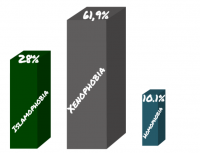29-12-2015, 19:58 Category: Media monitoring for hate speech, News
 School of Peacemaking and Media Technologies has presented its interim report "Hate Speech in
Media, Internet and Public Discourse of Kyrgyzstan – 2015”.
School of Peacemaking and Media Technologies has presented its interim report "Hate Speech in
Media, Internet and Public Discourse of Kyrgyzstan – 2015”.
The report was based on the analysis of hate content carried in the surveyed print, broadcast, online media and social networks in Kyrgyz and Russian languages for November-December 2015 and data compared to other periods of the year, as well as the findings based on field studies.
The freedom of expression in the media scene of Kyrgyzstan is closely related to the lexis of hate, which is based on clearly xenophobic statements, political incorrectness and emphasizes poor journalistic standards in the media, while posts in social networks sometimes provoke network aggression. Despite the fact that Kyrgyzstan ranks higher in the Press Freedom Index[1], than the neighboring states in Central Asia, it still has problems with ethics.
The discriminatory language against minorities was also detected in those media outlets that describe themselves as analytical media. In their articles and reports about the problems faced by minorities, authors also create their negative image. Thus, the media contribute to the spreading of xenophobia – ethnic, religious, social and other types.
In 2015, the number of social groups seen as targets
of hate speech and possible victims of hate crimes has increased. By the end of
the year, as analysis shows, the main targets of dehumanising metaphors and ad
hominem attacks were Muslims, Ethnic Groups and LGBT.
In previous years, however, negative response in the media focused more on ethnic groups.
In 2015, hate against refugees and foreigners, including foreign investors – Canadian, Chinese, Turkish –almost tripled in the society. Their ethnic (or national) background is discussed in the media and on the internet. The main part of articles, reports and posts is written in critical tone, whereas social networks often use offensive language. Activity of some foreign companies is being politicized. For instance, discussion of Kumtor gold mining company in a negative context resulted in the Canadians becoming one of the targets of hate speech. Now they are on the list of groups frequently mentioned in the media, against which humiliating clichés and stereotypes are used. A separate set of inhumane expressions in public discourse has been detected as used against Chinese companies involved in civil engineering, trade and service. "Chinese expansion” is a stereotype that is widely spread in all types of media. In the analyzed period, the Chinese led the rankings of ethnic groups being the victims of hate.
Homophobic attitudes in the media space are being supported by the discussion about the draft law on criminal liability for "forming a positive attitude towards non-traditional sexual relations” passed in the first hearing. Despite the fact that the LGBT issue is censored by the society and media, journalists and users address it on a weekly basis, mainly, in a negative tone.
A detailed summary of the report with diagrams can be found here
A group of experts keeps on summarizing data for 2015 and analyzing the content. A final report will be submitted in March 2016. The project is implemented by School of Peacemaking and Media Technologies of the Network of Social Mediators Public Foundation with the financial support of the Canada Fund for Local Initiatives (CFLI). The project aims to monitor and analysis of hate speech in the media and public discourse, development of recommendations, and public outreach campaign to prevent violence and discrimination against minorities in order to protect human rights and basic freedoms.

The School of Peacemaking and Media Technology in Central Asia announces an annual competition among students from Kyrgyzstan, Kazakhstan,…

25 journalists and media workers from various regions of Kyrgyzstan have been trained to counter the propaganda of violent extremism and hate in…